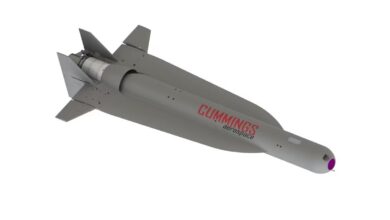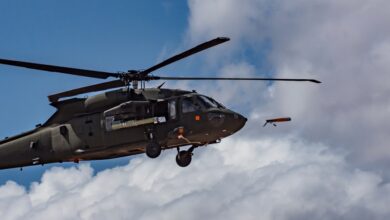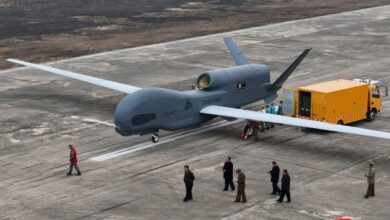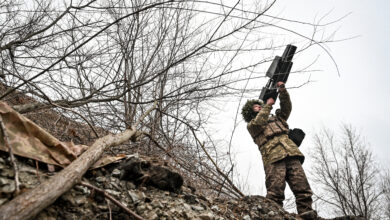Barkhane operations kill more than 30 ‘terrorists’ in Mali
More than 30 “terrorists” were killed during a recent series of operations conducted by the France-led Operation Barkhane force in Mali, the French Armed Forces Ministry said.
“In recent weeks, Barkhane has stepped up the pressure on armed terrorist groups, in the Tri-border area and beyond, through several one-off operations” that were hitting the terrorists hard, “challenging their freedom of action and limiting their capacity to cause harm,” the Thursday, January 23 release said.
Two operations earlier in the month were carried out in the Mopti region of central Mali, which the release said is “subject to the predation of the Katiba Macina,” one of the constituent groups of al-Qaeda-linked JNIM.
A commando operation on January 10 in northern Mopti “put three terrorists, including a logistics officer, out of action.”
Then, between January 14 and 15, during a helicopter-borne operation in southern Mopti that was marked by fierce fighting and several skirmishes, “a full combat group was neutralized.”
The Barkhane commandos were supported by helicopter gunships and an airstrike, and around 30 “jihadists were put out of action,” about 20 motorcycles were destroyed, and a large quantity of telephone equipment was captured.

In the morning of January 19, “five armed terrorists were neutralized by a drone strike” conducted in the Liptako, near Tindinbawen in Mali, not far from Inatès in Niger, an area where the release said Islamic State is “rampant.” Three motorcycles were also destroyed during the operation.
On December 10, more than 70 Nigerien soldiers were killed in a complex Islamic State attack on a military camp in Inates, the deadliest on Niger’s military since the armed forces began fighting Islamist militants in 2015.
‘Major’ arms seizure near Tessit
A separate joint operation in the Gourma conducted by the Malian Armed Forces (FAMa) supported by the French Desert Battle Group 1 (GTD-1) “Steel” between January 2 and 17 led to the seizure of weapons and more than 14,000 rounds of ammunition, the ministry said in a Wednesday release.
From the large base in Gao, the joint force moved to the Tessit area near the borders with Burkina Faso and Niger and carried out a sweep in which an AK pattern rifle, ammunition and a telephone were discovered.
GTD-1 personnel then discovered a PKM machine gun and nearly 2,500 rounds of ammunition in a wadi south of Tessit. A dog from the 132nd Army Canine Battalion was then dispatched to support the search and he detected two machine guns, an RPG-7 rocket launcher, four rifles and 10,000 rounds of ammunition.
The following day two dogs were sent to the area. A machine gun and a bag containing around 1,000 rounds of ammunition were discovered.
Last week, the French defense ministry said more than 1,000 troops from Mali, Burkina Faso, Niger, and Barkhane had taken part in a joint operation in the Liptako-Gourma region since January 2, including in the Tessit area. About fifteen “terrorists” were “put out of action” and vehicles, weapons and ammunition were seized or destroyed.
A week earlier, the ministry said that more than 50 “terrorists” were “put out of action” in a series of operations conducted in Mali between December 20 and January 5.

Coalition for the Sahel
The French military presence in the Sahel began in 2013 with Operation Serval in Mali, and evolved in August 2014 into Operation Barkhane, which has a mandate for counter-terrorism operations across the region. Roughly 4,500 French troops are deployed, and they focus activity in insurgent-hit Mali, Niger and Burkina Faso, working alongside local troops and other international operations, including the regional G5 Sahel Joint Force (FCG5S) which comprises troops from Burkina Faso, Mali, Niger, Chad and Mauritania, and MINUSMA, the United Nations stabilization mission in Mali.
On January 13, France’s President Emmanuel Macron and the leaders of the G5 Sahel states announced a new Coalition for the Sahel which will see increased coordination between French and local forces focused on the Mali-Burkina Faso-Niger tri-border zone and targeting Islamic State as a priority. The new Sahel Coalition will see Barkhane and the FCG5S forces operating under joint command.
Macron also announced that 220 more troops would be sent to the Sahel to reinforce Barkhane. On Wednesday, the Chief of the General Staff of the French Armed Forces General François Lecointre said that France will further reinforce the Barkhane force and send “additional logistical and intelligence” support.
Macron said the Sahel Coalition would prioritize the fight against ISIS in the tri-border area because it is the most dangerous.

France has for months been trying to build support for a new international special operations task force called “Takuba.” Armed Forces Minister Florence Parly said in November that France expected the new force to deploy in Mali by 2020.
Lecointre said on Wednesday that Takuba will declare initial military capability in the summer and “will be fully operational by the autumn.”
French media reported that France plans a 500-strong force.
Estonia was the first French partner to confirm a deployment to Takuba. A defense ministry spokesperson told The Defense Post in November that special forces will deploy to Mali in the second half of 2020 and that force will “assist, advise and accompany” the Malian Armed Forces. Belgium and the Czech Republic have also signaled that they will participate, but the U.S. and Germany have declined.
Norway’s Ministry of Defence told The Defense Post on Thursday that a deployment to Takuba is being considered, and Finland’s MoD said they had received a request to participate but could not “confirm any interest by Finland towards this initiative.” Discussions with Sweden are ongoing, according to French radio station RTL. Sweden’s defense minister accompanied his French counterpart on a trip to the region earlier this week.
Barkhane already has an international dimension, with France’s European partners contributing troops and equipment. Denmark deployed two Merlin helicopters that became operational in late December and Estonia is to almost double the size of its Barkhane contingent this year. Chinook helicopters from the United Kingdom also support the operation.
Islamist insurgents in the Sahel
The complex insurgency in the Sahel began in Mali in 2012, when a Tuareg separatist uprising was exploited by al-Qaeda-linked extremists who took key cities in the desert north. Former colonial power France launched Serval the following year, driving the jihadists from the towns.
But the militant groups morphed into more nimble formations operating in rural areas, and the insurgency gradually spread to central and southern regions of Mali and across the borders into neighboring Burkina Faso and Niger.
According to the U.N., around 4,000 people were killed in militant attacks in the three countries last year.
Many armed groups including Islamic State are active in the Sahel region, but the majority of attacks are attributed to JNIM, which formed in March 2017 from a merger of several smaller groups including. JNIM’s leadership has pledged allegiance to al-Qaeda leader Ayman al-Zawahiri.
Since May 2019, ISIS has attributed insurgent activities in the Sahel area to ISWAP, its West Africa Province affiliate that split from Boko Haram in 2016, rather than to Islamic State in the Greater Sahara. ISWAP’s main area of operations is the Lake Chad area of Nigeria, Niger, Chad and Cameroon.












